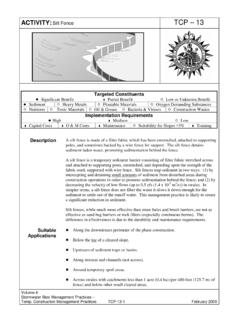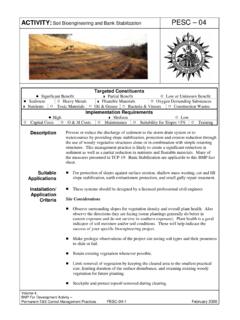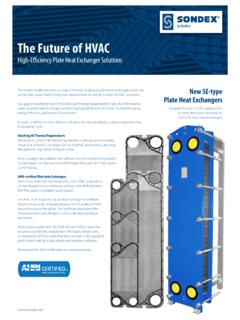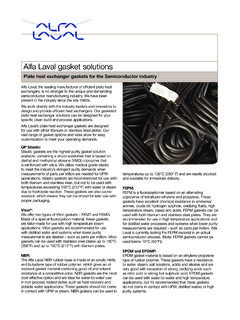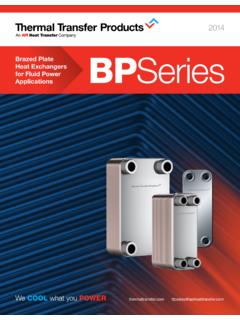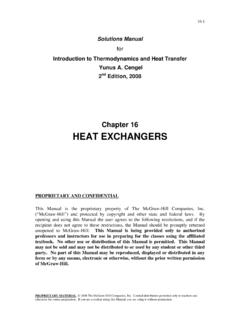Transcription of PFX Plate and Frame Heat Exchanger - Nashville, Tennessee
1 1 PFXP late and Frame heat ExchangerFILE NO. :Sept. 12, 2003 SUPERSEDES: :Aug. 30, 1999 INSTALLATION AND OPERATING INSTRUCTIONSTABLE OF Introduction .. Function & Components .. Gaskets .. Flow & Plate Arrangement .. Installation Procedures .. Lifting .. Piping .. Storage .. Operating Instructions .. General .. Start-Up .. Shut Down .. Maintaining the Exchanger .. Opening .. Closing .. Gasketing .. Cleaning the Exchanger .. Fouling .. Fully Assembled .. Disassembled .. Problem Solving .. 23 IntroductionArmstrong Plate heat exchangers have been installed world wide providing a wide variety ofheat transfer solutions using diverse fluids at different core of the Plate heat Exchanger is the thin metal corrugated thermal plates that bothenhance and conduct heat transfer through them. These thermal plates have an elastomergasket, confined in a formed groove around the perimeter of the Plate , that contains the fluidbetween the plates.
2 The plates with gaskets are then sequentially installed in to a compactpressure retaining Frame that distributes the fluid Function & FramesThe fixed Frame Plate (1) and the moveable pressure Plate (2) are dense steel plates de-signed for withstanding high pressures and containing the fluid thermal plates are arranged in the Frame by hanging from the upper carrying bar (3) andkept in alignment by the lower guide bar (4). The bars are supported by the Frame Plate infront and in the back by a support column (5) when necessary. A roller bearing assembly (6)is used on larger units for easier maintenance. The tightening bolts (7) bring the thermalplates to metalic contact while compressing the elastomer gasket sufficiently to PlatesDepending on the heat transfer solution and the fluids being applied the Plate corrugation orsurface pattern and its thickness will vary. As the thermal Plate s corrugation depth lessensso can it s Plate .. Fixed Pressure Plate2 ..Movable Pressure Plate3.
3 Upper Carrying Bar4 .. Lower Carrying Bar5 ..Support Column6 ..Roller Bearing Assembly7 .. Plate Pack Tie Bars 53267414 Armstrong offers the following surface patterns in a variety of thickness:5 GasketsThe gasket that goes between each Plate to separate and seal the two fluids is either glued inplace or is affixed to the Plate using mechanical or a glue free circular ring portion of the gasket prevents the fluid from going across the thermal plateand sends it on to the next open Plate or channel. The remaining field portion of the gasketchannels the opposing fluid across the Plate / heat transfer demonstrated above the two fluids are isolated by the gasket. To prevent possible inter-mixing of the fluids between the ring and field portions of the thermal Plate special vents areprovided in this unpressurized fluids escaping from either side will exit the heat Exchanger through these vents. Theseopenings must not be plugged as cross contamination of fluids could this design any gasket failure will only result in detection on the outside of the heatexchanger and no inter mixing of the two Flow & Plate ArrangementThe plates are arranged in an alternating pattern of L style ( left hand flow ) or R style( right hand flow ) to alternate the two opposing fluids in the heat Exchanger .
4 The assembly ofthe thermal plates between the fixed Frame Plate and the moveable pressure Plate is calledthe Plate pack .WARNING!For proper assembly and sealing of the thermal platesin the Plate pack, the plates must be alternated betweenL and R style. Consequently, the chevron pattern on theplates must alternate between pointing up and down!!6 The first or starter Plate in a Plate pack does not have fluid flowing across it. Instead it has fourring gaskets to seal against the inside of the connections on the fixed Frame Plate . In thismanner, the fluids are diverted to open channels in the Plate pack and do not go between thestarter Plate and the fixed Frame following are some typical flow arrangements found in Plate heat exchangers:Ring Gaskets(Four Corners)7 The connection locations may vary for a given Plate heat Exchanger design. Since all ofArmstrong Plate heat exchangers are parallel or same side flow, all connections for one fluidwill only be on the right side and for the opposing fluid on the left side.
5 The connection loca-tions are defined as follows:Every Armstrong PFX Plate heat Exchanger is provided with a Plate arrangement drawingshowing the proper sequencing and alignment of the thermal plates in the Plate pack. Thefollowing are some standard rules that must be followed when performing maintenance workon the Plate heat Exchanger ; All plates are stamped with an L at one end and an R at the other to assist inproper orientation of the plates. Typically the odd number plates (1,3,5,..) are installed with the R at the top and theeven number plates (2,4,6,..) with the L at the top to alternate the fluid flow to everyother The chevron pattern must always be rotated 180 degrees from Plate to Plate . Forexample if plates 1,3,5,.. are pointing up then plates 2,4,6,.. should be pointingdown. The first Plate shall be double gasketed as shown on page 6. Units with more than one pass require circular ring gaskets to seal between themoveable pressure Plate and the back side of the last thermal Plate .
6 Specially holed plates may be used in accordance with the following figures:9 Installation Liftinga) Refer to nameplate for overall weight of unit. Be sure lifting equipment is overrated for the ) Location A is designed for a clevis , or lifting straps. Both points are to be ) Location B should have a lifting strap wrapped around the carry bar, closest to the pressure ) Units with high Plate quantity will require the use of a spreader ! Do not lift using port connections, tie rods or pressure Plate !!! InstallationThe Plate heat Exchanger should be installed with approximately 3 feet of open spacearound it for future special considerations for space, these dimensions may be reduced but servicingthe heat Exchanger may be heat Exchanger must be mounted on a foundation that is level and adequate enough sothere is no settling which could cause a strain on the unit and the attached Lifting ArrangementSpreader Bar Arrangement10 A liquid retaining trough or drip tray with a volume capacity equal to that of the heat exchangershould be mounted under the Plate pack for corrosive services or applications where there iszero tolerance for process fluids being on the connections to the Plate heat Exchanger should be equipped with shut-off valves so theunit may be shut down and opened up without disturbing the entire system.
7 To avoid waterhammer, quick action valves should not be used. WARNING! The unit should be tightened to the Plate pack dimensions per assembly drawing and nameplate prior to proceeding with piping dependable operation avoid sudden pressure and/or temperature surges to the heatexchanger. Provide safety relief valves where the maximum pump discharge pressure mayexceed the design pressure of the unit. Pumps should have throttling valves and controlvalves should be located at the inlets to the heat Exchanger . Vibration dampers shall be usedon positive displacement pumps and particularly reciprocating pumps. WARNING! Sudden fluctuations in pressure or temperature can cause temporary gasket leakage in Plate air vents in piping near the high point of the heat Exchanger for proper venting and atthe low point in the piping for proper to installation inspect all the ports of the heat Exchanger for foreign debris that couldbecome lodged during following are typical connection types used for installing Plate heat studs secure the flanges to the fixed Frame Plate .
8 Alloy or rubber linings are addedas necessary to prevent smaller connection sizes threaded NPT type connections are !When installing units with alloy nozzles, the nozzlesmust be held in place by a wrench to avoid PipingPiping to the Plate heat Exchanger shall be designed so that it s thermal expansion andweight do not put too much force on the nozzles causing premature forces or moments applied to the nozzles of the Plate heat Exchanger must be ap-proved by a Plate heat Exchanger has connections on the moveable pressure Plate there arespecial considerations; Since the pressure Plate is not fixed, it s nozzles can withstand less loading thanthe nozzles on the Frame Plate . The Plate pack may be subject to re-tightening during service therefore whenattaching piping to the pressure Plate allow for this difference ( approximatelyplus or minus 1% of the final Plate pack tightening dimension ). The pressure Plate must move backward for servicing. Use elbowed spoolpieces for easy StorageIf the Plate heat Exchanger is to be stored for an extensive time period the following proce-dure should be used; Store at 60-70 degrees F in a closed room.
9 Tightening bolts and Plate pack should be totally un-tightened. heat Exchanger should be totally covered in black plastic. Avoid heat , ultraviolet and welding light. Apply a rust preventative to all carbon steel machined parts ( bolts, )12 Operating GeneralThe Plate pack tightening dimension must be as specified on the nameplate or assemblydrawing before operating the Plate heat Exchanger . Note: If plates have been added orremoved to original heat Exchanger consult Armstrong for proper tightening dimension. Iftightening is required turn to Opening & Closing for proper !Before putting a Plate heat Exchanger in operation, be certainthe entire system is free of sand or particles that will plug theunit during and be certain that the system is set up so it does not exceed the design pressure ortemperature of the heat Start UpAlways start up the Plate heat Exchanger with the fluid circuit that is at the lower pressureand temperature;1) Close the feed valve located between the pump and the heat ) Open fully the shut off valve at the ) Open the vent ) Start the ) Open the feed valve very ) When all the air is removed close the vent valve7) Repeat process for the other fluid circuitSpecial considerations during start up shall be given when condensing steam in one circuit; Never have the steam side on with the liquid side off.
10 The steam must always be turned on second and shut off first. Steam valves must be set to open gradually to avoid damaging prevent shocking the heat Exchanger the steam side should be slowly brought up todesign conditions by controlled throttling of the cold side Shut Down1) Starting with the fluid circuit at higher temperature and pressure, slowly close thefeed ) Turn off the ) Close outlet valve4) Repeat procedure for the other fluid long term storage or maintenance, vent and drain the heat Exchanger . Prior to storageflush and or clean the plates to remove any corrosive procedures are recommended for any heat Exchanger that will be out of service fora month or Maintaining the OpeningThe Plate heat Exchanger must be completely shut down and drained in accordance with theprevious section before ) If the unit has connections on the pressure Plate , the piping must be removed inorder to allow it to move freely backward on the carrying ) The carrying bar should be inspected and wiped ) Use a wire brush to clean the threads of the tightening bolts and then lubricatethem with a thin layer of molybdenum disulphide or other equivalent ) Carefully remove the safety shield from the ) The plates can either be sequentially marked as they are removed from the unitor a diagonal line can be drawn across Plate pack to record each Plate s 6) Record the actual Plate tightening dimension A.

